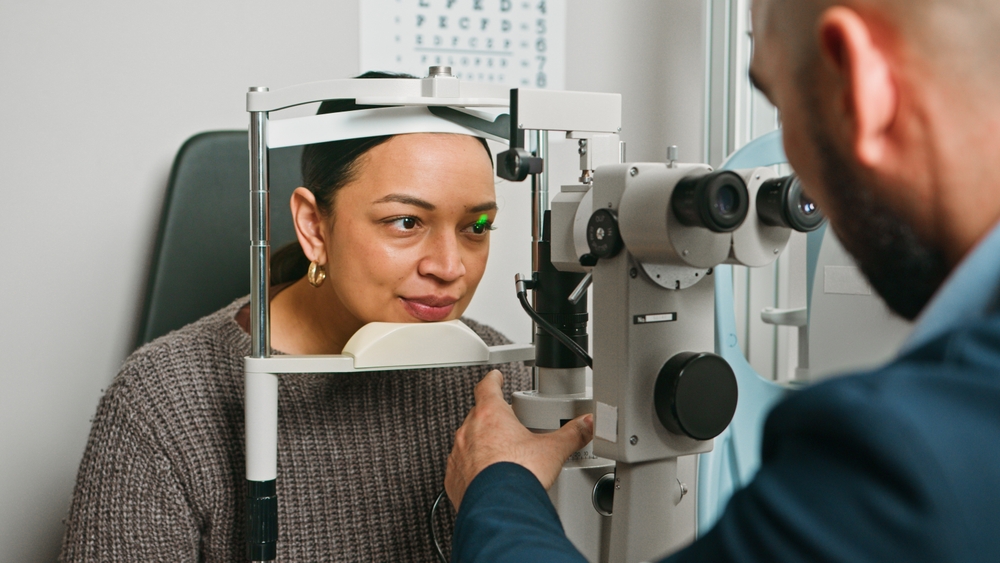Diabetes affects more than just blood sugar levels. For many people living with diabetes, the disease poses a serious threat to vision through a group of conditions collectively known as diabetic eye disease.
The connection between diabetes and vision loss is both direct and preventable, yet many people don’t realize their eyesight is at risk until damage has already occurred. Keep reading to learn more about the conditions that affect diabetic patients, how to recognize warning signs, and when to see your eye doctor!
What is Diabetic Eye Disease?
Diabetic eye disease encompasses several distinct conditions that develop when elevated blood sugar levels damage the delicate structures of the eye.

The term covers four primary conditions:
- Diabetic retinopathy
- Diabetic macular edema (DME)
- Cataracts
- Glaucoma
Each condition affects different parts of the eye, but all share a common origin in the metabolic changes caused by diabetes.
The danger of diabetic eye disease lies in its silent progression. Damage can happen over time in the retina, lens, and optic nerve long before patients notice any change in their vision.
By the time blurriness, floaters, or vision loss becomes apparent, significant and sometimes irreversible harm has already occurred. This pattern makes annual comprehensive dilated eye examinations essential for anyone diagnosed with diabetes, regardless of how well-controlled their blood sugar levels appear to be.
How Diabetes Damages Your Eyes
Diabetes alters how the body processes and stores sugar from food. Whether from insufficient insulin production (type 1 diabetes) or from the body’s resistance to insulin (type 2 diabetes), elevated blood glucose levels damage small blood vessels throughout the body.
The eye contains some of the most delicate blood vessels in the human body, making it particularly susceptible to this type of damage.
In the retina, damaged blood vessels may begin to leak fluid or blood, causing swelling and deposits that distort vision. As damage progresses, the retina becomes starved of oxygen. In response, the eye attempts to grow new blood vessels, but these fragile vessels are prone to bleeding and can lead to severe complications, including retinal detachment.
This progression from early vessel damage to the formation of abnormal new vessels defines the spectrum of diabetic retinopathy, the most common form of diabetic eye disease.
The lens and optic nerve face different threats. Adults with diabetes develop cataracts at higher rates than people without diabetes, and these cataracts tend to appear at younger ages. Diabetes also increases the risk of glaucoma, a disease that damages the optic nerve and can result in permanent vision loss.
The Four Conditions That Threaten Vision for Those With Diabetes
Diabetic Retinopathy involves progressive changes to the blood vessels in the retina. In its early stage, called non-proliferative or background retinopathy, damaged vessels leak blood or fluid into the retina.
Fluid accumulation can cause swelling, and if this swelling affects the macula (the central area responsible for detailed vision), patients experience blurred vision. The more advanced form, proliferative diabetic retinopathy, occurs when oxygen-deprived retinal tissue triggers the growth of abnormal blood vessels. These weak vessels bleed easily, form scar tissue, and can cause retinal detachment. Diabetic retinopathy ranks as a leading cause of blindness among working-age adults in America.
Diabetic macular edema develops as a consequence of diabetic retinopathy. Swelling in the macula disrupts the sharp, straight-ahead vision needed for reading, recognizing faces, and driving. About half of all people with diabetic retinopathy will develop DME at some point, making it the most common cause of vision loss among diabetic patients. DME can emerge at any stage of diabetic retinopathy, not just in advanced cases.
Cataracts cloud the normally clear lens of the eye. While cataracts eventually affect most people as they age, diabetes accelerates this process significantly. The earlier onset means diabetic patients may need cataract surgery during their working years rather than in retirement.
Glaucoma damages the optic nerve, which transmits visual information from the eye to the brain. Several types of glaucoma involve elevated pressure inside the eye, and diabetes substantially increases the likelihood of developing these conditions.
How Do Annual Eye Exams Save Vision?
It’s recommended that people with diabetes receive comprehensive dilated eye examinations at least once a year. A dilated exam performed by an ophthalmologist differs significantly from the brief eye checks sometimes included in routine diabetes management visits with primary care physicians.

Ophthalmologists use specialized equipment to evaluate the entire eye in detail, identifying early signs of damage that simpler examinations miss. This allows for the earliest possible diagnosis and treatment.
Damage also typically occurs before symptoms appear. Blood vessels may already be leaking, swelling may be developing in the retina, and pressure may be rising inside the eye while vision still seems perfectly normal.
Annual examinations catch these changes at stages when treatment works most effectively. When diabetic changes appear in the eye, similar vascular damage is likely occurring elsewhere in the body, where detection is more difficult, making the eye exam a window into overall diabetic health.
How is Diabetic Eye Disease Treated?
Treatment approaches vary depending on the specific condition and how far it has progressed.
The earliest stages of diabetic retinopathy often require only careful monitoring and strict blood sugar control, which can slow or halt progression. As the damage progresses, however, more advanced treatments may be necessary.
Laser surgery has served for decades as a proven treatment for diabetic retinopathy. During the procedure, a focused beam of light shrinks abnormal blood vessels or seals leaking vessels in the retina. While laser treatment can reduce the risk of severe vision loss, it typically cannot restore vision that has already been lost.
Modern treatment increasingly relies on intravitreal injections of anti-VEGF medications, including Avastin and Lucentis. These drugs, injected directly into the eye, have proven both safe and effective for treating diabetic macular edema and proliferative diabetic retinopathy. Patients often receive monthly injections, sometimes in combination with laser treatments.
Cataracts are removed through surgical procedures that replace the clouded lens with a clear artificial lens.
Glaucoma treatment focuses on lowering eye pressure through medicated eye drops, laser procedures, or surgery, depending on the severity and type of glaucoma.
Don’t assume that good blood sugar control eliminates the need for specialized eye care. Schedule an appointment at Eye Care & Vision Associates in Buffalo, NY, today to ensure your vision is protected.

